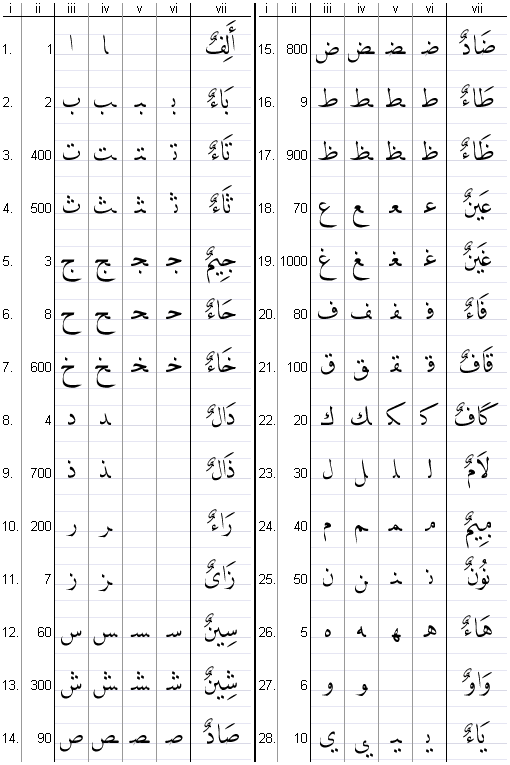Abdschad (number system)
| If characters are not displayed correctly in the following, this is due to the font, see Representation of Arabic numbers in Unicode and help with representation problems . |
The Abdschad number system , abjad for short (also Abjad ), is the alphabetical number system of the Arabs. Abdschad actually means something like "the Arabic ABC ". According to the old order of the Arabic alphabet , which was still based on the Phoenician alphabet , ابجد (a bah dschah dah) were the first four Arabic letters . Before the Arabic numerals were adopted by the Arabs in the 9th century, the Arabic letters also formed the Arabic number system. In the years of the Hijra era, the alphabetical numbers are preferred to this day.
After a terminological advance by Peter T. Daniels in 1990, Abdschad (or Abjad ) is also used as a synonym for consonant writing.

Notation
Numerical values of the letters
The assignment of letters to numerical values is based on the old order of the Arabic alphabet (the table on the right, however, lists the alphabet in the current order). The letters were divided into three groups of nines, as well as the numerical values of the Greek letters and the Hebrew letters :
- The first group shows the numbers from 1 to 9.
- The second group shows the tens from 10 to 90.
- The third group gives the numbers from 100 to 900.
- The last letter at that time (now number 19) was set equal to 1000.
To help you remember , the letters are arranged in eight words, the first of which - abdschad ( ابجد ) - also means alphabet :
- ابجد - abdjad : 1–2–3–4
- هوز - hawwaz: 5–6–7
- حطي - hutti: 8–9–10
- كلمن - kalaman: 20-30-40-50
- سعفص - sa'fas: 60-70-80-90
- قرشت - qaraschat: 100–200–300–400
- ثخذ - thachidh: 500-600-700
- ضظغ - dazagh: 800-900-1000
Identification as a number sign
To avoid ambiguity due to confusion with words, it is usually common to draw a line across the Arabic alphabetical numbers.
The year 1429 of the Hijra (that is, January to December 2008 according to the Christian calendar) is written: غتكط
Modified system in the Maghreb
Since some letters were changed in the Maghreb, there is a modified Abdschad in western North Africa in addition to the traditional oriental Abdschad. There, the letter Sad gelten applies to the 60, the letter Dad ض for 90, the letter Za ظ for 800, the letter Ghain غ for 900 and the letter Schin ش for 1000.
The memory aid looks like this (grouped one behind the other) as follows:
أبجد ﻫوز حطي كلمن صعفض قرست ثخذ ظغش
(for example: "abudschadin hawazin hutiya kalman sa'fad qurisat thachudh taghusch")
history
Until the gradual adoption of Indian numbers by the Arabs in the course of the 9th century, alphabetical numbers were also used in science and administration.
Some Middle Eastern alphabets had adopted the Greek letter and number system very early and applied it to their own alphabets. For example the Hebrew alphabet at the end of the 2nd century BC. And the Syrian alphabet in the middle of the 4th century AD.
In the Islamic-Arab sphere of influence, after the conquest of the former Eastern Roman areas of the Middle East and North Africa, especially Egypt, the Greek numbers were initially "literally" adopted. The Arabic texts of the Umayyad period (660–750) are regularly interspersed with original Greek numbers. After that, during the Abbasid period , the Greek numbers were replaced by the corresponding letters from the Arabic alphabet.
After the adoption of the Indian numerals, the old numbers were occasionally used by tradition, similar to the way in which the Roman numerals are still partially used in the West today. The Abdschad numbers can still be found today, for example, in the chapter numbering of Arabic books and in tables. They are also used in the so-called number mysticism .
Web links
- Bernhard Peter: Abjad - number mysticism with the Arabic script
- Islamisches Zentrum Schwerin eV: digits and numbers
Individual evidence
- ↑ Peter T. Daniels: Fundamentals of Grammatology . In: Journal of the American Oriental Society 110 (1990), pp. 727-731.
- ↑ See Peter T. Daniels, William Bright (Ed.): The World's Writing Systems. Oxford University Press, New York NY et al. 1996, ISBN 0-19-507993-0 .